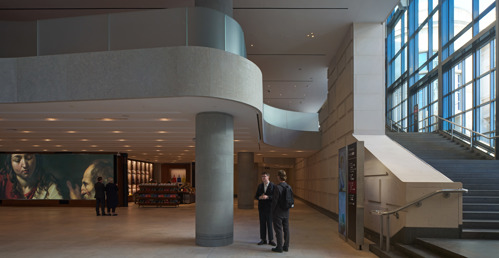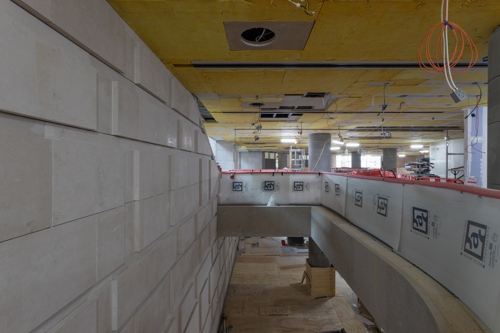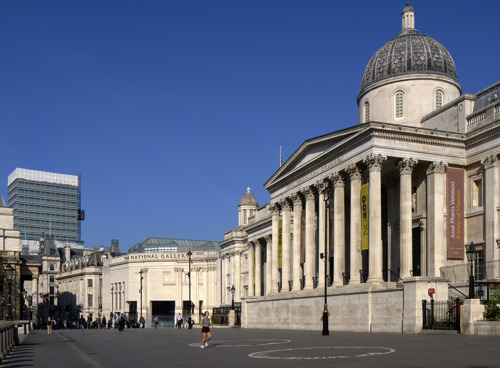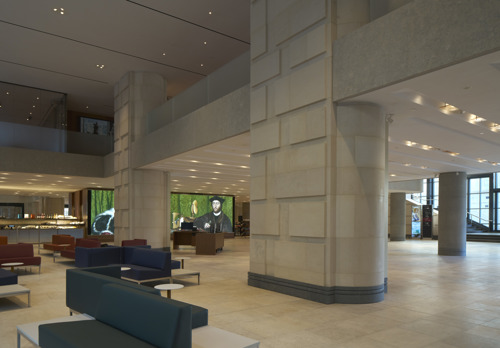Special Projects
Our Special Projects team is dedicated to providing complex heritage restoration schemes with the technical excellence and expertise they deserve.
Project Manager, Eugene McCormick, outlines the technical and operational challenges of working on an iconic London landmark
The National Gallery is home to famous works of art and attracts millions of visitors from around the globe each year.
The NG200 project, led by our Special Projects team in collaboration with Blue Sky Building, was undertaken as part of the gallery’s bicentenary celebrations, delivering major transformation to the Sainsbury Wing which we originally built in the 1980s.
Project Manager, Eugene McCormick, was at the centre of the two-year programme, ensuring the safe progression of the build with minimal disruption to the Gallery’s day-to-day operations.
At every turn, the team was careful to keep visitors safe, keep staff informed of the programme of works and protect the Gallery’s reputation, while delivering significant change in an historic listed building.
Eugene outlines some of the key considerations and challenges of working on such a high profile project, and how the team overcame them by working closely with the client and our supply chain partners.
 Centuries-old artwork is hyper sensitive to even the slightest change in light or humidity. If excessive vibration or dust touches a work of art, the impact could be irreversible. We were working in a highly pressurised environment which takes patience and skill.
Centuries-old artwork is hyper sensitive to even the slightest change in light or humidity. If excessive vibration or dust touches a work of art, the impact could be irreversible. We were working in a highly pressurised environment which takes patience and skill.
With the help of trade contractors and design team, we adopted alternative technical solutions to undertake the required structural alterations to the Sainsbury Wing while preserving the Gallery’s artwork and keeping other parts of the building safely open to visitors.
One of the client’s primary objectives was an improved public entrance in the Wing’s foyer, which necessitated the removal of large sections of first floor heavily reinforced concrete slab to create double height spaces. Breakers create a huge amount of noise, vibration and dust, so our team meticulously dismantled the slabs using a drill and burst method, drilling hundreds of holes into the concrete and using hydraulic bursters to break it apart in smaller stages to minimise any risk to the artwork.
 Part of our work also included the construction of the first phase of an underground link from the Sainsbury Wing, which sat on traditional piling, to the Wilkins Building, over 200 years old with masonry walls on traditional foundations.
Part of our work also included the construction of the first phase of an underground link from the Sainsbury Wing, which sat on traditional piling, to the Wilkins Building, over 200 years old with masonry walls on traditional foundations.
In a careful, complex operation to underpin and strengthen the Wilkins Building, we dug by hand on a hit-and-miss basis, excavating two-and-a-half metres deep by one metre wide before concreting back up quickly to avoid undermining the whole building. The meticulous approach ensured the job was completed without incident and enabled us to cast the new link foundations. As with the removal to slabs in Sainsbury wing, the removal of redundant wailing beam, piles and slab had to be carried out by drilling and bursting method due the proximity of art galleries above.
Strict vibration monitoring was always in place, agreed with the structural engineers and the client’s conservation department, yet things could change on a day-by-day basis, and work which had no impact one day might kickstart vibrations the next day, particularly in the Roden Centre for Creative Learning. We always had to be at the top of our game.
The Gallery’s unique location – in the heart of Westminster adjacent to one of London’s biggest attractions, Trafalgar Square – presented a series of logistical challenges which we managed in flexible and creative fashion.
The access route for our large deliveries was via the Square itself and could only be facilitated during a two-hour slot prior to peak commuter and tourist footfall. If it wasn’t in by 8am, it wouldn’t arrive until the following morning. In the context of such a tight deadline, the impact can be a domino-style effect, and you can quickly find yourself falling behind.
Trafalgar Square is also a hub for major events and is often taken over by third parties. For example, UEFA set up a Champions League festival ahead of the 2024 final at Wembley, meaning our primary access point was closed for nearly a week. Add up the sheer number of similar events over a two-year period and the days your main site access point becomes inaccessible soon rack up.
 Thanks to the strength of our relationship with Westminster Council, we had good insight on any disruption and worked with our supply chain to co-ordinate around it. We were also able to obtain the relevant consents and licences for our logistics and site operations, including receiving deliveries via Whitcomb Street, running parallel to the Sainsbury Wing.
Thanks to the strength of our relationship with Westminster Council, we had good insight on any disruption and worked with our supply chain to co-ordinate around it. We were also able to obtain the relevant consents and licences for our logistics and site operations, including receiving deliveries via Whitcomb Street, running parallel to the Sainsbury Wing.
Additionally, the project required a large degree of mechanical and electrical work, and the plant room is served from the North side of the building. These services ran straight through a loading bay usually reserved for the Gallery’s operations, with highly confidential deliveries arriving and rendering the space out of bounds at short notice.
Our loading bay access requirements were presented to the client’s internal stakeholders by David, our Chief Engineer, to give them a greater understanding of the reasons why we were working in this sensitive area, which had to be kept operational at all times. We agreed a period between exhibitions where our team could gain access and work flat out to get the bulk of the M&E work done, before liaising for ad-hoc access for the smaller, remaining jobs.
Finishing a project of this magnitude - just over two years from the enabling works to completion – is no mean feat. The project was driven by the Gallery’s bicentenary celebrations and finishing on time to coincide with their planned re-opening was non-negotiable.
Put simply, there is no way we could have delivered it working in silo.
In talking about ‘we’, the emphasis is on the whole project team, from the trade-contractors and supply chain partners to the client and design team. It was imperative we all came together to foster a collaborative, solution-focused culture, and that all parties buy into it.
 Once work was under way, we held weekly meetings with all trade contractors and the client to identify any potential issues and come up with effective ways to tackle them without slowing the work on site down. Our site team also provided extensive support to trade contractor managers, supervisors and the workforce, helping with things such as site logistics, health and safety, quality and all things operational.
Once work was under way, we held weekly meetings with all trade contractors and the client to identify any potential issues and come up with effective ways to tackle them without slowing the work on site down. Our site team also provided extensive support to trade contractor managers, supervisors and the workforce, helping with things such as site logistics, health and safety, quality and all things operational.
By putting transparency at the forefront of our conversations, we got on top of unexpected challenges as they arrived and came through by showing flexibility, thinking creatively and constantly communicating with stakeholders at every step.
The challenges of working on a listed building in the centre of London certainly kept us on our toes but the level of craftsmanship and quality on show is a true testament to our team, Trade-contractors and supply chain.
Read more about the National Gallery’s NG200 transformation and the official Royal opening by King Charles III and Queen Camilla in our feature: Royal approval for Special Projects team
Our Special Projects team is dedicated to providing complex heritage restoration schemes with the technical excellence and expertise they deserve.
As 2025 draws to a close, we explore key milestones, partnerships, innovative solutions and award-winning projects shaping the future of sustainable engineering and construction.
Therme Manchester introduces healthy, sustainable meals for its construction team, setting a new wellbeing standard in the industry.
Our IHP healthcare team achieved an impressive 127 out of a possible 130 score following the project end review.


